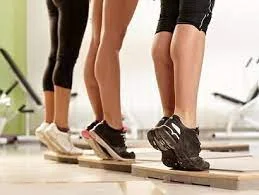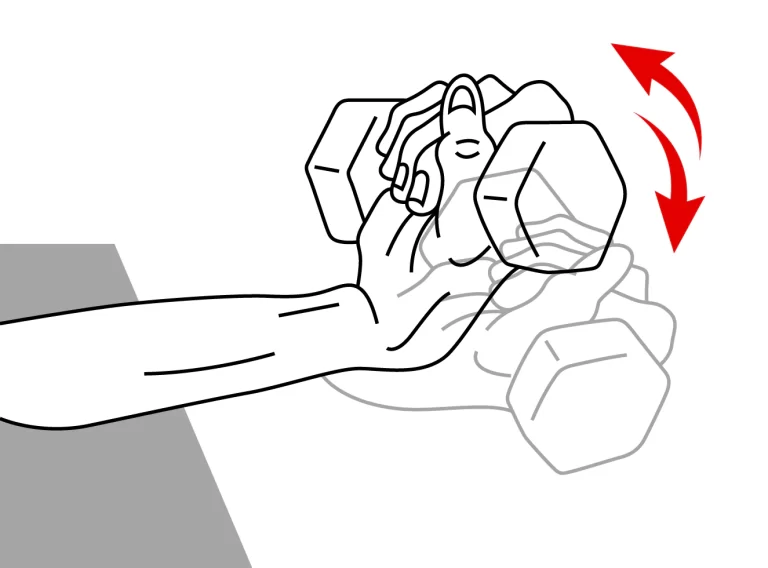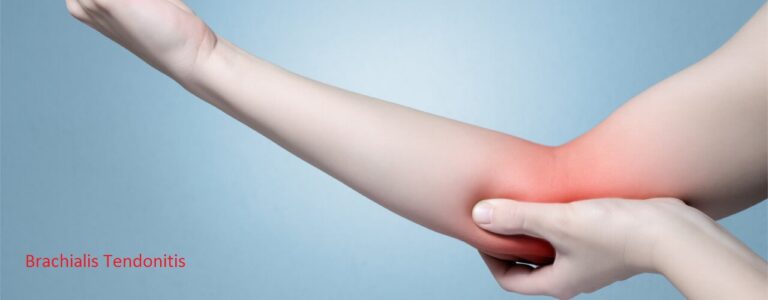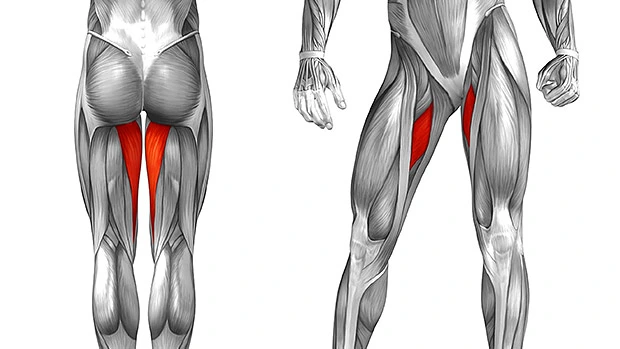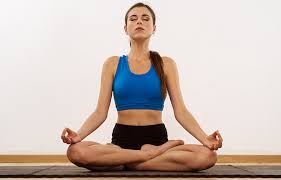30 Best Standing Yoga Poses
Table of Contents
Introduction
- Standing yoga poses are excellent for developing strength and stability, especially the balancing poses.
- Standing poses are an essential component of a well-rounded hatha yoga practice, requiring both strength and flexibility.
- Standing postures tend to be more energetically uplifting and opening than other positions, and they are often maintained for shorter periods of time between two and four breaths.
- This category contains most of the advanced asanas, so beginners need to focus on the basic standing poses to build a solid understanding and foundation of alignment and muscular engagement.
- The foundation of Vinyasa Flow Yoga is standing poses, which set the pace and intensity of the practice.
- Although certain sequences are timeless (like Sun Salutations), the allure of Flow lies in the many ways in which postures may be mixed and matched.
- Your body is put to the test in unexpected ways by each inventive sequence or artistic transition, which makes the practice enjoyable and unique.
- Generally speaking, a standing pose is any position in which the majority of your weight is supported by your feet.
- Although your hands are on the floor in a number of the positions we’ve featured, your legs are still making the majority of the effort.
- While revolved positions involve twisting, standing balances call for you to support yourself on one leg at a time.
- There are several benefits to incorporating yoga into your daily practice, including increased flexibility, better digestion, better sleep, and support for mental well-being.
- Not to mention, you can perform this kind of workout in almost any place.
- This is especially true for any standing yoga positions, which theoretically don’t require a mat.
- Not only are standing yoga poses a great way to strengthen and stretch during the day, but they’re also a great way to improve stability and balance.
- These are often more stimulating positions that you maintain for a shorter period of time.
- Yoga is a highly beneficial workout modality for improving your balance.
- Particularly standing yoga postures provide several advantages in addition to being an excellent means of enhancing that ability.
- A foot or both must be anchored in the ground for all standing yoga postures, including the chair, tree, and mountain.
- Standing yoga postures are considered a means to align all three via your connection to the earth since yoga is an ancient discipline founded on synchronizing your breath with your body and mind.
- Regardless of how long you have been performing power yoga sessions or how fresh you are to the postures, standing poses remain an essential part of the entire practice.
- Yoga flow sequences use a variety of yoga asanas or poses to take you from standing to sitting to lying down on the floor, or vice versa.
- For example, Chen says that the majority of Vinyasa yoga sun salutations are standing poses.
- Step back onto a high plank after beginning the sun salutation in the mountain position.
- From there, you go into a forward fold, half standing with a flat back.
Tips for standing yoga poses
- To prevent strain or injury, keep your ankle, foot, and knee alignment correct.
- When you require support, especially in balancing positions, use a wall or chair.
- To help you maintain your equilibrium, use a drishti or focus point.
- To stabilize your legs, use pada bandha.
- When holding these positions, especially the more difficult ones, take calm, deep breaths.
- You may adjust by bending your knees or using a yoga strap if your hamstrings are tight.
30 Best Standing Yoga Poses
Following are the best-standing yoga poses for building strength and stability
Mountain Pose [Tadasasana]
![Mountain Pose [Tadasasana]](https://mobilephysiotherapyclinic.net/wp-content/uploads/2023/12/Mountain-Pose-Tadasasana.webp)
Sanskrit Meaning: Tada (Mountain)
Benefits: Improves body awareness and establishes fundamental standing posture.
Steps To Follow:
- Position yourself at the front of the mat, feet parallel.
- Place your hands on your hips and sense a forward tilt in your pelvis.
- Place your lower body over your lower limbs.
- Stack your shoulder girdle over your pelvis and release your arms at your sides with the palms facing front.
- Maintain a neutral head position by allowing your neck to be the natural extension of your spine.
- All standing poses where the pelvis faces the front of the mat start with this position.
Raised Hands Poses[Urdhva Hastasana]
![Raised Hands Poses[Urdhva Hastasana]](https://mobilephysiotherapyclinic.net/wp-content/uploads/2023/12/Raised-Hands-PosesUrdhva-Hastasana.webp)
Sanskrit Meaning: Urdhva (Upwards) Hasta (Hand)
Benefits: An excellent stretch for the arms, shoulders, back, and tummy.
Steps To Follow:
- Breathe in to extend your arms sideways and upward toward the ceiling from Mountain Pose.
- You can either maintain your palms facing each other shoulder-width apart or bring them to touch overhead.
- Reach up and look at your thumbs
Standing Forward Fold Poses[Uttansana]
![Standing Forward Fold Poses[Uttansana]](https://mobilephysiotherapyclinic.net/wp-content/uploads/2023/12/Standing-Forward-Fold-PosesUttansana.webp)
Sanskrit Meaning: Uttanana (Intense Stretch)
Benefits: Lengthens the hamstrings, glutes, and back muscles.
Steps To Follow:
- Exhale to release your arms from the Raised Hands Pose and push your pelvis forward to perform a swan dive over your legs.
- Touch your ankles or the floor with your fingertips.
- Let go of your head.
Chair Poses[Utkatasana]
![Chair Poses[Utkatasana]](https://mobilephysiotherapyclinic.net/wp-content/uploads/2023/12/Chair-PosesUtkatasana.webp)
Sanskrit Meaning: Utkata (Powerful)
Benefits: Strengthens your thighs. Stretches your back and shoulders.
Steps To Follow:
- Bend your knees forward to bring your butt back, as if you were going to take a seat, starting from Mountain Pose.
- Make sure your toes are visible through the gap by taking a quick look at your knees.
- Raise your arms so that they are in line with your torso’s diagonal.
Downward Facing Dog Pose[Adho Mukha Svanasana]
![Downward Facing Dog Pose[Adho Mukha Svanasana]](https://mobilephysiotherapyclinic.net/wp-content/uploads/2023/12/Downward-Facing-Dog-PoseAdho-Mukha-Svanasana.webp)
Sanskrit Meaning: Adho (Downward) Mukha (Face)Svana (Dog)
Benefits: Improves core, leg, and arm strength. Opens the back muscles and the backs of your legs.
Steps To Follow:
- Start with your hands and knees.
- Twist your toes downward.
- As you release breath, push your butt toward the sky and straighten your legs by pressing into your palms.
- Your physique resembles an inverted V.
- Maintain the pressure on your palms while letting go of your heels to the ground.
- Give your head a hefty hang.
Warrior I Poses[Virabhadrasana I]
![Warrior I Poses[Virabhadrasana I]](https://mobilephysiotherapyclinic.net/wp-content/uploads/2023/12/Warrior-I-PosesVirabhadrasana-I.webp)
Sanskrit Meaning: Virabhadra (a Hindu warrior)
Benefits: Strengthens the legs and core. Improves awareness of hip alignment.
Steps To Follow:
- Step your right foot forward to the inside of your right hand from Downward Facing Dog.
- To release your left heel to the mat at a 45-degree angle, pivot on the ball of your left foot.
- As you take a breath, raise your hands off the ground to raise your body to a standing posture.
- To improve stability and allow your pelvis to point forward as it would in Mountain Pose, move your feet back toward either side of your mat.
- As you raise your arms over your head, take a breath and bend your right knee over your right ankle.
- Keep your hands shoulder-distance apart with your palms facing each other, or bring them to contact.
- Lift your eyes to your thumbs.
Humble Warrior Pose
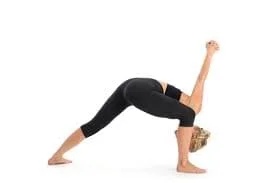
Also Known As: Devotional Warrior Pose
Benefits: Improves leg and core strength. Opens the shoulder and back muscles.
Steps To Follow:
- Straighten your arms by drawing your knuckles down and tying your hands behind your back as you do Warrior I.
- Put your hands together and lift them toward the sky as you bend forward to the inner of your right foot.
- To keep your hips and legs in the Warrior I position, continue to hug your head in toward the midline.
Pyramid Pose[Parsvottanasana]
![Pyramid Pose[Parsvottanasana]](https://mobilephysiotherapyclinic.net/wp-content/uploads/2023/12/Pyramid-PoseParsvottanasana.webp)
Sanskrit Meaning: Parsva (Side) Uttana (Intense Stretch)
Benefits: A stretch for the hamstrings and back.
Steps To Follow:
- Straighten your right leg and step your left foot forward 10 to 12 inches from Warrior I Pose, making sure your left toes maintain their 45-degree rotation.
- To ensure that your hands are in Mountain Pose with your palms facing forward, place them on your hips.
- As you forward fold over your right leg on a breath out, and maintain a long spine.
- Maintain a modest flexion in your right knee to avoid overextending it.
- Touch the ground with your hands or the blocks on each side of your right foot.
- On your inhales, keep your spine long, and on your exhales, deepen your forward fold.
High Lunge Pose
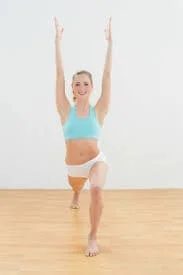
Benefits: Strengthens your legs and core. Improves balance.
Steps To Follow:
- Step your right foot to the inside of your right hand from Downward Facing Dog.
- With your arms up and your right knee bent over your right ankle, elevate your chest toward the ceiling while taking a breath.
- With your shoulders sliding down your back, bring your right thigh parallel to the floor.
Warrior III Pose[Virabhadrasana III]
![Warrior III Pose[Virabhadrasana III]](https://mobilephysiotherapyclinic.net/wp-content/uploads/2023/12/Warrior-III-PoseVirabhadrasana-III.webp)
Sanskrit Meaning: Virabhadra (a Hindu warrior)
Benefits: Strengthens the legs and core. Improves balance and body awareness.
Steps To Follow:
- Step forward with your right foot in Warrior I and raise yourself onto the ball of your left foot.
- Place your hands on your hips to ensure they are level and looking forward as you bring your left leg nearly parallel to the floor.
- Lean your chest forward, push off your left foot to lift it away from the floor, and shift your weight into your right leg.
- firmly bend your left foot in.
- Place your arms in a straight line from your fingers to your heel by placing them next to your ears.
Warrior II Pose[Virabhadrasana II]
![Warrior II Pose[Virabhadrasana II]](https://mobilephysiotherapyclinic.net/wp-content/uploads/2023/12/Warrior-II-PoseVirabhadrasana-II-1.webp)
Sanskrit Meaning: Virabhadra (a Hindu warrior)
Benefits: Strengthens the arms, legs, and core.Improves consciousness of open hip alignment and balance.
Steps To Follow:
- Step forward with your right foot in Warrior I and extend your left toes so that your left foot is parallel to the Central Line.
- Open your shoulders and hips to the left, and shift your front right foot to the Central Line.
- Your right knee should be bent over your right ankle.
- It might be necessary for you to slightly move your left foot back.
- The chest and pelvis should be facing the left side of the mat.
- With your left arm back and your right arm forward, bring your arms parallel to the floor.
- Cast your eyes over your right index finger.
Reverse Warrior Pose
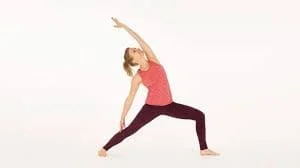
Also Known As Peaceful Warrior Pose
Benefits: Strengthen your legs. Elongates your side body and intercostal muscles.
Steps To Follow:
- Breathe in and raise your right arm beside your right ear while in Warrior II with your right foot forward.
- Bend backward toward the rear of the room and extend your spine to reach your left hand down the back of your left leg.
- Maintain the position of your right knee over your right ankle.
Extended Side Angle Pose[Utthita Parsvakonasana]
![Extended Side Angle Pose[Utthita Parsvakonasana]](https://mobilephysiotherapyclinic.net/wp-content/uploads/2023/12/Extended-Side-Angle-PoseUtthita-Parsvakonasana.webp)
Sanskrit Meaning: Utthita (Long Version) Parsva (Left) Kona, the Angle
Benefits: Strengthens your legs and core. Opens your hips, shoulders, and back.
Steps To Follow:
- Reach forward with your right hand in Warrior II and insert the palm inside your right foot.
- To open your chest toward the ceiling, use the traction between your right knee and right shoulder.
- Should you find it uncomfortable to expand your chest, place a block beneath your right hand or extend your right forearm to the top of your right leg.
- Raise your left arm while looking up at the ceiling.
- Throughout, maintain your right knee over your right ankle.
- If you would like, tuck your left arm behind your left ear.
Triangle Pose[Trikonasana]
![Triangle Pose[Trikonasana]](https://mobilephysiotherapyclinic.net/wp-content/uploads/2023/12/Triangle-PoseTrikonasana.webp)
Sanskrit Meaning: Trikona (Triangle)
Benefits: Opens your hamstrings, chest, and sides.
Steps To Follow:
- Straighten your right leg after performing Warrior II with your right foot forward.
- Deepen the crease in your right hip by extending your right arm as far forward as you can.
- Reach down and touch your right ankle, shin, or a block inside or outside of your right leg with your right hand.
- Turn your chest and look up at the ceiling while crossing your left arm across your right.
Half Moon Pose[Ardha Chandrasana]
![Half Moon Pose[Ardha Chandrasana]](https://mobilephysiotherapyclinic.net/wp-content/uploads/2023/12/Half-Moon-PoseArdha-Chandrasana.webp)
Sanskrit Meaning: Ardha (Half) Chandra (Moon)
Benefits: Improves balance and leg strength. Opens your hamstrings and chest.
Steps To Follow:
- Lower your right hand to the outside of your right foot in Warrior II.
- Raise your left foot off the ground while maintaining a soft right knee, then extend your right hand forward 8 to 12 inches.
- Raise your right leg straight and place your pelvis over your right foot.
- Make sure your pelvis is positioned in a Warrior II position by kicking out the heel of your straight left leg forcefully.
- Gaze up to your left fingertips while opening your left arm and chest toward the ceiling.
Tree Pose (Vrksasana)
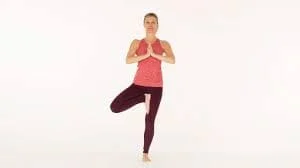
Sanskrit Meaning: Vrksa (Tree)
Benefits: Improves leg strength and balance.
Steps To Follow:
- Maintaining your pelvis pointed forward, transfer your weight into your right leg from Mountain Pose.
- Place the left foot’s sole within your right thigh after lifting it off the ground.
- To maintain your pelvis looking forward as it did in Mountain Pose, press your foot into your thigh and your thigh back into your foot.
- As you take a breath, raise your arms and look up at the ceiling.
Half Lotus Tree Pose[Ardha Padmasana Vrksasana]
![Half Lotus Tree Pose[Ardha Padmasana Vrksasana]](https://mobilephysiotherapyclinic.net/wp-content/uploads/2023/12/Half-Lotus-Tree-PoseArdha-Padmasana-Vrksasana.webp)
Sanskrit Meaning: Ardha (Half) Padma (Lotus)Vrksa (Tree)
Benefits: Improves leg strength and balance. Hip opener.
Steps To Follow:
- Assume a Half Lotus posture by sliding the top of your left foot into the crease of your right hip from Tree Pose.
- As you plant your left foot firmly in your right leg, your left knee is pointing downward.
Eagle Pose[Garudasana]
![Eagle Pose[Garudasana]](https://mobilephysiotherapyclinic.net/wp-content/uploads/2023/12/Eagle-PoseGarudasana.webp)
Sanskrit Meaning: Garuda (Eagle)
Benefits: Improves balance and pelvic alignment awareness. Stretches the upper back and shoulders.
Steps To Follow:
- Shift your weight into your right leg from the Chair Pose.
- As you raise your left foot off the ground, cross your left leg over your right leg.
- Put your left foot behind your right leg.
- Maintain the forward-facing Mountain Pose posture with your pelvis.
- Subtly place your left arm beneath your right.
- With both elbows bent, encircle your right forearm with your left palm so that your palms contact.
- As you move your shoulders down your back, raise your upper arms parallel to the floor.
King Dancer Pose[Natarajasana]
![King Dancer Pose[Natarajasana]](https://mobilephysiotherapyclinic.net/wp-content/uploads/2023/12/King-Dancer-PoseNatarajasana.webp)
Sanskrit Meaning: Nataraja (King of the Dance)
Benefits: Improves leg and core strength. Opens the shoulders and chest.
Steps To Follow:
- Shift your weight into your right leg from Mountain Pose.
- Raise your left foot off the ground and flex your left knee until your left foot is almost in contact with your left rear end.
- With your thumb pointed downward, extend your left hand back and grasp the outside part of your left foot.
- Raise your right arm in the direction of the ceiling.
- Start to twist your pelvis forward, bringing your left thigh closer to the ceiling and your upper body forward.
- To keep extending your chest and raising your left knee, press your left foot onto your left hand.
One-Legged Chair Pose[Eka Pada Utkatasana]
![One-Legged Chair Pose[Eka Pada Utkatasana]](https://mobilephysiotherapyclinic.net/wp-content/uploads/2023/12/One-Legged-Chair-PoseEka-Pada-Utkatasana.webp)
Sanskrit Meaning: Utkata (Powerful) Pada (Foot) Eka (One)
Benefits: Gentle hip opener and balance challenge. Builds leg strength.
Steps To Follow:
- Without shifting your pelvis, shift your weight into your right leg from the Chair Pose.
- With your left knee facing left, raise your left foot off the ground and bring it up to the top of your right thigh.
- Firmly flex your left foot.
- Place your hands above or in the center of your chest.
- Hold the Chair Pose with your right leg extended.
Sugarcane Pose[Ardha Chandra Chapasana]
Sanskrit Meaning: Chandra (Moon) Ardha (Half) Chapa (Bow)
Benefits: Increases Ardha Chandrasana’s quad stretch and balancing difficulty.
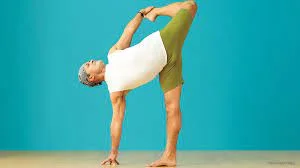
Steps To Follow:
- Bend your left elevated knee in Half Moon Pose and bring your left heel to your left buttock.
- Reach your left hand to grasp your left ankle after lowering your left arm behind your back.
- Put your left foot to use.
- Bend your left leg back and your chest forward by pressing your left foot against your left hand.
Pose B: Standing Hand to Big Toe[Padangusthasana B, Utthita Hasta]
Sanskrit Meaning: Hasta (Hand) Utthita (Extended) Padangustha (Big Toe)
Benefits: Stretch your hamstrings and strengthen your legs and core.
![Utthita Hasta Padangusthasana B]](https://mobilephysiotherapyclinic.net/wp-content/uploads/2023/12/Utthita-Hasta-Padangusthasana-B.webp)
Steps To Follow:
- Shift your weight into your right leg from Mountain Pose.
- Take off your left foot and bring your left knee up to your chest.
- Using the first two fingers of your left hand, hold your left big toe.
- Lift your left leg straight and face the front of the room.
- Keep your left arm in its socket and your body in the Mountain Pose position.
- Keep your upper body in proper alignment by bending your left knee or, if needed, wrapping a strap over the ball of your foot.
- For the B version shown, stay in this position or spread your left leg to the left.
Revolved Standing Poses
Benefits: A nice twist for the abdomen and back.
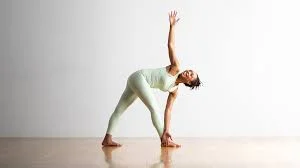
Steps To Follow:
- From Dog Facing Downward.
- Place your right foot within your right hand and stride.
- You should have your right ankle covered by your bent right knee.
- Plant your left palm firmly and raise your right arm above your head.
- Turn your head to face the ceiling while rotating your chest.
Revolved Chair[Parivrtta Utkatasana]
Sanskrit Meaning: Parivrtta (Revolved) Utkata (Powerful)
Benefits: Improves leg and core strength. Rotates the spine.
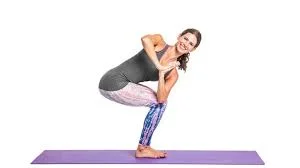
Steps To Follow:
- Take a seat first. Put your hands at your sternum in the Anjali Mudra pose.
- Elevate your left elbow and rotate it away from your center of mass to bring it outside of your right knee while exhaling.
- Maintain a low butt and bowed knees.
- To deepen your twist on exhalations, press your left upper arm onto your right outer thigh.
Revolved One-Legged Chair[Parivetta Eka Pada Utkatasana]
Sanskrit Meaning: Parivrtta, or “Revolved” Utkata (Powerful) Pada (Foot) Eka (One)
Benefits: Combining multiple elements like balance and twisting improves coordination and body awareness.
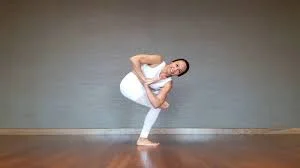
Steps To Follow:
- With your hands in the Anjali Mudra at your sternum and your right leg as your standing leg, start off in the One-Legged Chair Pose.
- Breathe out and raise your left elbow, then twist from your core to bring your left upper arm to the outside of your right leg, the sole of your left foot.
- Maintain the chair position with your right leg bent.
- To intensify the twist on your exhalations, press against your right arm.
Revolved Half Moon[Parivrtta Ardha Chandrasana]
Sanskrit Meaning: Parivrtta (Revolved) Ardha (Half) Chandrasana (Moon)
Benefits: A challenging twist on balancing exercises the legs and belly.
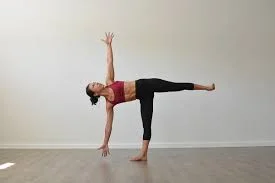
Steps To Follow:
- Step your right foot to the inside of your right hand from Downward Facing Dog.
- As you raise your left foot off the ground and shift your weight into your right leg to do a standing split at the front of your mat, move both of your hands forward by 10 to 12 inches.
- As you flex your left foot and bring your left leg parallel to the floor, maintain your pelvis toward the floor.
- As you reach your right hand to your right hip, you might wish to place a block beneath your left hand.
- As you turn your chest to face the right side of the mat, try to stack as much of your right shoulder on top of your left.
- Lift up your right arm and look up at the ceiling.
Garland Pose[Malasana]
Sanskrit Meaning: Mala (Garland)
Benefits: The benefits of a thorough hip stretch offset the negative consequences of chair sitting.
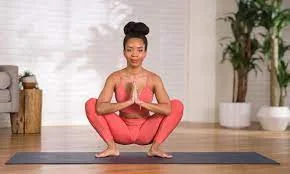
Steps To Follow:
- Extend your toes 45 degrees and place your feet about 12 inches apart from Mountain Pose.
- With your butt near the floor, lower yourself into a deep squat by bending your knees.
- If needed, spread your feet farther apart.
- To grind into your heels, make sure they are on the ground.
- Put a rolled-up blanket below your elevated heels so you can support your weight with them.
- In the Anjali Mudra, bring your hands to your chest and your elbows inside your knees.
- Gently press your knees apart using the pressure from your elbows.
Goddess Pose[Utkata Konasana]
Sanskrit Meaning: Utkata (Powerful) Kona (Angle)
Also Known As Horse Pose
Benefits: Opens the hip and groin. Strengthens your feet and legs.
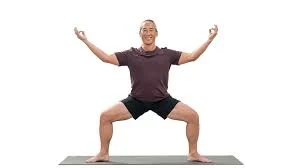
Steps To Follow:
- Stretch your legs wide in a straddle position and turn to face the side of your mat.
- To bring your knees over your ankles, bend them and spread your toes 45 degrees.
- It can be necessary to modify the spacing between your feet.
- Try your hardest to keep your knees from folding inward by keeping them positioned over your toes.
- Raise your hands to your chest in the Anjali Mudra or adopt a different arm posture.
Lizard Pose[Utthan Pristhasana]
Sanskrit Meaning: Utthan (Intense) Pristha (Back)
Benefits: Hamstrings, quadriceps, glutes, and hip flexors are all strengthened and stretched.
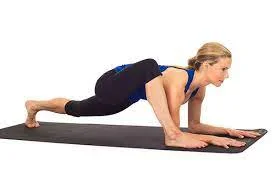
Steps To Follow:
- Step your right foot to the outside of your right hand from the downward dog position.
- With your forearms parallel and your hands flat, lower your elbows to your mat.
- Either maintain your left leg straight and apply pressure via your heel, or drop your left knee to your mat.
Side Lunge Pose[Skandasana]
Sanskrit Meaning: Skanda (Hindu War Deity)
Benefits: Stretches your hamstrings and calves. Strengthens your core, quads, and glutes.
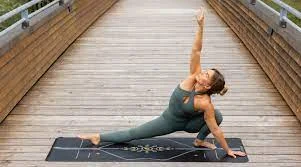
Steps To Follow:
- Stretch your legs wide in a straddle position and turn to face the side of your mat.
- Maintaining your left leg straight, bend your right knee into a deep squat, keeping your butt close to the floor.
- Come onto your left heel by flexing your left foot.
- Press firmly into your right heel.
- As you open your left arm and chest toward the ceiling, tuck your right arm inside your right leg.
What are the advantages of yoga’s standing positions?
- Standing positions provide a number of advantages.
- Standing poses that strengthen and stabilize the legs, glutes, and core muscles include Mountain, Tree Pose, and Warrior.
- Upper body strength may also be developed by standing in poses like Warrior 2 and Triangle Pose with the arms lifted.
- These are grounding postures that strengthen Muladhara, the root Chakra, and aid with equilibrium.
- Numerous of these poses increase upper limb and hip flexor flexibility.
Conclusion
While some individuals want to vary things up, others enjoy practicing the same set of postures over and over again. With so many distinct postures to choose from, you can construct many standing sequences and combinations that will strengthen your body and help you focus on the here and now.
FAQ
The yoga positions known as standing asanas are those in which the body is essentially erect and one or both feet are planted on the floor. These are some of the most unique aspects of practicing yoga today.
Standing stances such as Warrior Pose and Tadasana (Mountain Pose) require us to be perfectly balanced between observance and movement. In order to do these asanas, we must extend our bodies upward while firmly planting our feet and keeping proper alignment and balance.
Then there are standing yoga postures like aircraft, warrior III, eagle,
tree, and dancer’s pose that not only help you develop strength but also greatly sharpen your balance. One foot is frequently placed on the floor when performing standing balance poses, which places all of your weight on one leg.
Standing, sometimes called orthostasis, is a stance in which the feet are the only source of support and the body is maintained erect (“orthostatic”). In the sagittal plane, the body appears to be immobile, although it really shakes slightly from one ankle to the other.
Standing has other advantages besides the possibility of weight reduction. According to medical research studies, standing for just thirty minutes a day can reduce your chance of dying from heart disease. That danger can be reduced by more than 33% by standing for 90 minutes. The advantages mount up the longer you stand.
References:
- 15 Standing Yoga Poses That Will Build Full-Body Strength & Balance. (2022, October 4). Mindbodygreen. https://www.mindbodygreen.com/articles/standing-yoga-poses
- 15 Standing Yoga Poses For Building Strength & Their Benefits. (2023, December 28). Digit Insurance. https://www.godigit.com/health-insurance/exercise/standing-yoga-poses
- 30 Standing Yoga Poses: The Foundations of Flow. (2023, November 21). Liforme. https://liforme.com/blogs/blog/30-standing-yoga-poses-the-foundations-of-flow
- R., & R. (2023, December 20). Yoga Asanas: Standing, Sitting, and Lying Down Yoga Poses. The Art of Living – Making Life a Celebration. https://www.artofliving.org/in-en/yoga/beginners/beginner-yoga-asanas-for-everyday
- Standing Yoga Poses • Yoga Basics: Yoga Poses, Meditation, History, P. (n.d.). Yoga Basics. https://www.yogabasics.com/practice/yoga-postures/standing-yoga-poses/


